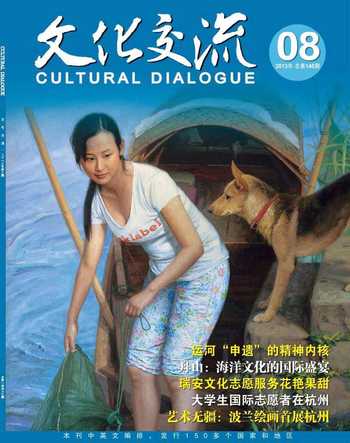明清时期的太平洋丝绸之路
2013-04-29柯嘉囝
柯嘉囝



曾经纵横世界海洋的西班牙大帆船,也是太平洋丝绸之路来往使用的主要船只。
Spanish galleons once dominated the oceans of the world. They also plied the Pacific Ocean between Manila and Acapulco.
相知不以万里为远。中国和拉丁美洲国家的交流在明清时期就已经十分密切,并对相互之间的政治、经济、文化、社会产生了深远的影响。
太平洋上的贸易纽带
16世纪70年代至19世纪初叶,中国和拉美之间存在着一条太平洋丝绸之路。
西班牙自1565年逐步侵占菲律宾诸岛,由此开辟了环太平洋航路。1571年,西班牙人在明都洛外海营救了一艘中国船只。1572年,闽南商人把许多价值不菲的商品运到马尼拉,其中包括丝绸、瓷器和熏香、麝香、金属制品以及水果、肉食腌腊品等等。西班牙人全部买下后,转运到墨西哥的阿卡普尔科。阿卡普尔科位于太平洋沿岸、距离墨西哥城约300公里,是墨西哥格雷罗州重要的港口城市。从此,从中国沿海诸港至马尼拉再至阿卡普尔科的航班年年往来。
太平洋丝绸之路建立后,中国货便源源不断地进入美洲。丰富的产品多数是中国生产,有些则是闽南商人在菲律宾生产。这些产品涉及织染刺绣缝纫、酿酒煎糖榨油、制鞋制革制毡、木作泥作石作、打金打银打铁打铜打锡,以及印刷装订、烧石灰的熬蜡烛的做油漆等行业。
运到墨西哥、转运美洲各地的中国货物成千上万,但丝类货物始终占突出的位置。这些中国丝绸和绣品,有罗纱、绉纱和镶嵌有金银线的浮花锦缎,有衣料、披肩、丝单被、手帕、台布、袜子、裙子,还有女性上衣、男性长袍,以及教堂法衣、育婴堂襁褓,名目繁多,品质粗细均有,但都是畅销货。
中国丝织品物美价廉,在1640年前后,运到墨西哥的中国丝织品是西班牙同等货物的三分之一,中国的织锦质量远比西班牙的线缎要好很多,而售价只有其一半。1592年,中国输入美洲的货物总值已经超过西班牙。
墨西哥的丝织业在1530年左右开始发展,到1541年,已开始生产塔夫绸和天鹅绒。1600年,西班牙王室立法禁止美洲殖民地种植桑树,导致墨西哥刚刚兴起的丝织业面临断粮的绝境,正是从中国运来的生丝解救了墨西哥城、普埃布拉和安特奎拉等地的丝织业,可以重新开机。由此可见,中国生丝已和墨西哥丝织业休戚与共了。
太平洋丝绸之路,给拉丁美洲带去了经济繁荣。明清两代,中国市场上流通的银元日益增多,输入中国的墨西哥银元(鹰洋)大约相当于中国原来拥有的白银的六分之一,或更多一些。这对于自15世纪中叶以来已代替钞票日益流通白银的中国而言,无疑也有很大的补益。
不过,有学者认为,墨西哥银元是压垮大明帝国的最后一根稻草。大明帝国利用白银进行管理制度改革,但没有建立起中央银行、战略物资储备这些与白银相对应的安全系统。致使大明经济一度处于裸奔状态。当大明帝国和张献忠、李自成以及与满清的战争逼来时,这个平衡被打破,原有的白银矛盾爆发出来,失去了安全阀,只能坐看局势的崩溃。
墨西哥独立战争期间的1815年,当最后一艘运输中国货物的西班牙商船结关、离开阿卡普尔科,便宣告了这条太平洋丝绸之路的终结。
美洲大陆的农耕传播
明清之际,中国出现资本主义萌芽,但终究还是农业为主导。地理大发现后,美洲一些土生土长的粮食作物、经济作物、蔬果作物,被引种到欧洲、东南亚,并通过这些地区传入中国,这给以后中国的经济生活、社会习惯和科技文化发展带来了很大的影响。
美洲种植玉米已有5000年以上的历史,哥伦布说它甘甜可口。16世纪,中国从西亚阿拉伯人那里引入玉米,称为“玉麦”。16世纪末,李时珍在《本草纲目》记载湖北开始种植玉米。19世纪初,四川、陕西、湖北、湖南的山地都种玉米,玉米成为“山农之粮”。
番薯和中国2000多年前在两广地区栽种的甘薯属于不同品种。1584年、1585年,番薯从菲律宾、越南传入闽南晋江。1594年福建大旱,人们靠番薯度过了灾荒。后来,福建人又从文莱等地引入番薯新品种,一颗苗头可产十多斤,于是逐渐从闽浙推广到黄淮、华北。
马铃薯原产地是秘鲁和智利。17世纪,荷兰人把马铃薯带到台湾,后传种福建,被称为“洋芋”。稍后,爪哇也有马铃薯传入广东,称为“荷兰薯”。19世纪,东北开始种植马铃薯,被称为“土豆”。
中国5000多年前就有土生小粒花生,汉代时叫“余甘子”,但栽种不广。巴西大粒花生16世纪中叶从南洋传入福建、广东、浙江与太湖流域,文献中最早记载在明代的嘉靖《常熟县志》、万历《嘉定县志》、黄省曾《种芋法》、王世懋《学圃杂疏》。巴西大粒花生“引蔓开花,花落即生”,明人因而称之为“落花生”。
哥伦布发现新大陆时,有一随从在中美洲一个小岛Tobacco,看见吸烟本是印第安人在集会、迎宾时的一种社交方式。16世纪70年代后,烟草从菲律宾吕宋岛传入台湾和福建,或说从印度尼西亚、越南传入广东,再扩散各地;北方则从日本经朝鲜半岛传入东北,再入关内。东北戍边明军和垦殖流民以吸烟提神解乏、驱寒取暖,于是种烟取利,明廷屡禁不绝。1641年,尚在关外的满清取消禁令。
西红柿原产安第斯山北部的山谷。16世纪由教会人士传入中国。1613年,《猗氏县志》(猗氏县治在猗氏镇,今属山西省运城市临猗县)记载此物,称之为“西番柿”。西红柿在中国,直到19世纪还只是一种观赏植物,后来成为栽培最为普遍的果菜之一。
辣椒原产国是墨西哥。16世纪,辣椒从南洋传入中国,称为“海椒”“辣子”“辣茄”,明人高濂《遵生八笺》《草花谱》、清人陈淏子《花镜》都有著录。辣椒是理想的调味品,内地山区和北方的寒冷地带都普遍栽种。辣椒引种后,中国对胡椒、丁香等价格昂贵的香料进口量大为下降。四川、湖南、贵州菜肴也都少不了辣味,成为八大菜系中的地方特色。
(本文图片由郭成钢、韩笙提供)
Silk Road on Pacific Ocean from Ming to Qing
By Ke Jianan
From 1565 to 1815 there existed a ship trade between Manila , the Philippines and Acapulco, New Spain (Mexico now), operated by Spain. It is commonly known as the Manila-Acapulco Galleon Trade and the route is designated by some Chinese scholars as Silk Road on the Pacific Ocean. They argue that though the trade was operated by Spaniards and ships were largely Spanish galleons, a large bulk of commodities were made in China and supplied by Chinese merchants and that silk was the most important export of the commodities shipped across the Pacific.
The trade started in 1565. It is not clear whether Chinese goods were on the first galleon on its way to Acapulco. If not, Chinese merchants must have soon become aware of the demand for this cross-Pacific trade. In 1571, a Chinese merchant vessel from Fujian, a coastal province geographically embedded between Zhejiang in the north and Guangdong in the south, ran into trouble on the sea near the Philippines. It was rescued by the Spanish colonists. In 1572, another ship from Fujian arrived at Manila with a full shipload of silk, porcelain, perfume and musk, metal products, fruit and preserved meat. The shipload from Fujian was sold wholesale at Manila and transshipped to Acapulco.
As Chinese goods became the bulk of the commodities shipped from Manila to Acapulco, the galleons were often referred to as China ships because they carried Chinese goods. In 1592, 20 years after history registered the first Chinese shipload of goods joined the galleon trade, the Chinese goods surpassed the Spanish goods in terms of transaction value.
As the trade flourished, many more ports beyond those in Fujian along the coastline of China began to send out ships to Manila and supply the major quantity of the goods. Some manufacturers in Fujian even moved to Manila to set up their factories, to be closer to the market and cut down costs. The Chinese manufacturers in the Philippines made a vast range of goods.
Of the numerous kinds of Chinese goods that went from Manila to Acapulco, silk was arguably the most valuable. Around 1640, the Chinese silk goods shipped to Mexico accounted for 33% of the Spanish silk goods, but Chinese silk was much superior in quality but cheaper by 50%.
The galleon trade helped Mexico to save its silk weaving industry. Silk weaving started in Mexico around 1530. By 1541, Mexico manufacturers were able to make taffeta and velvet. The industry ran into a crisis in 1600 when Spain imposed a ban on mulberry tree cultivation in its colonies in Americas. The raw silk shipped from China saved the situation and factories that had run out of raw silk were able to resume production.
The trade brought economic prosperity to Americas and it brought a large quantity of silver dollars to China. During the Ming (1368-1644) and the Qing (1644-1911), 16% of the silver dollars circulating in China came from Mexico. The dollars were important to Chinas economy because silver had replaced paper money in the mid 15th century. However, some scholars believe that silver dollars from Mexico were the last straw that crushed the Ming. In absence of a central banking system and strategic materials reserves, the Ming failed to finance its military campaigns against inland rebellions and invading Qing from the north.
In 1810, the Mexican War of Independence broke out. When the last Spanish galleon cleared the customs and left Acapulco behind in 1815, the ship trade that had last 250 years ended.
Additional big benefit that came with silver to China as the result of the Manila-Acapulco Galleon Trade was important agricultural crops. Some Latin American crops came to China via Europe and Arab, but some came from the Southeast Asia, apparently as the result of the trans-Pacific Ocean trade.
Corn came to China from the west in the 16th century. Toward the end of 16th century, farmers in central Chinas Hubei province began to plant it. In the early 19th century, it was widely cultivated in mountainous areas in Sichuan, Shanxi, Hubei, and Hunan provinces and it served as a staple food for people in mountains. Sweet potato was introduced to southern Fujian province in 1584 and 1585 from the Philippines and Vietnam respectively. People in the province survived a killer drought in 1594 mainly because of the crop. Sweet potato later spread to other provinces.
Peanuts, tobacco and hot pepper arrived in China in the 16th century from Southeast Asia. The imported pepper was so popular with people living the west and south that it has long since been a key ingredient in regional cuisines in Sichuan, Hunan and Guizhou. After pepper was introduced, import of spice dropped sharply.
The introduction of agricultural products from Americas was no coincidence at a time when the galleon trade between Manila and Acapulco was flourishing and ships shuttled between Manila and Fujian.
